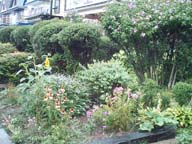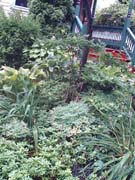More lawn trashing
I may not use a bicycle (not for a fifteen mile commute), I don’t save my scraps for compost (compost heap=yuck), and I don’t recycle as much as I should, but this morning NPR confirmed that by not growing grass, I am helping to spare the natural environment and reduce greenhouse gases.
Of course, I’ve always been against the use of grass in small urban spaces for largely aesthetic reasons. Suburbanites seem to understand the care and feeding of grass and nurture/worship it accordingly—albeit with detrimental chemicals, extravagant watering, and polluting mowers. City-dwellers just seem to throw the seed down and hope for the best. They mow it when the nagging gets unbearable. The plots are usually characterized by bumpy terrain, weeds, brown spots, and bare spots. On my street, every year a few people make pathetically unsuccessful attempts to grow grass in the easeway between walk and street. It never, ever works out—yet, they continue. It’s so sad; eventually, a few thin spears poke out through the burlap. Then, when they take the burlap off, most of the grass comes away with it.
The experts on NPR (actually Great Lakes Radio Consortium) were pointing out a three-fold scenario of the environmental damage done by grass-growing: 1.) the mowers are made without catalytic converters and thus throw out more carbon dioxide (among other contaminants) than the average car; 2.) grass requires near-constant watering, thus depleting a natural resource; and 3.) grass requires high nitrogen and phosphorous fertilizing, creating run-off into nearby streams, lakes, and rivers. The car comparison was the most dramatic: one hour of power mowing may cause as much pollution as driving a car 1300 miles. Some say it’s more like 3200 miles. (Most gardeners already know about water shortages and the dangers of chemicals.)
Digression: There was this guy, an English grad student living in Kenmore (a suburb of Buffalo), who refused to mow his lawn for years. It was covered with three-dozen varieties of wildflowers, many of which he had planted—and he did, in fact, weed and till the space. This guy received death threats, gunshots were fired at the house, and snakes were placed in the yard—all by his neighbors. He was eventually fined by the village for violating an ordinance, which he fought, semi-successfully, in court. Eventually, neighbors mowed the lawn illegally while he was on vacation. He lives in the Appalachian Mountains now. His dissertation was to be on Thoreau. I don’t know if he finished it.
Back to the NPR guys: They had some compromise solutions, like buying drought-resistant grasses, mowing high, and pointed out—another interesting revelation—that a light sprinkling daily may be more effective than deep watering twice-weekly. Whatever. My advice: by any means possible, avoid grass. There are many, many alternatives.
Here are a couple grass-free front yards I spotted last summer:


Addendum: I'm for just about any ground cover over grass, including pachysandra, which I find easy to contain. But there is also sweet woodruff (gallium odorata), vinca, and many, many types of lamium. All of these flower; most lamium will flower for most of the season. I woud also propose hardy geranium (cranesbill) as a potential ground cover. All of these would be great in tough spots, like easeways.
Of course, I’ve always been against the use of grass in small urban spaces for largely aesthetic reasons. Suburbanites seem to understand the care and feeding of grass and nurture/worship it accordingly—albeit with detrimental chemicals, extravagant watering, and polluting mowers. City-dwellers just seem to throw the seed down and hope for the best. They mow it when the nagging gets unbearable. The plots are usually characterized by bumpy terrain, weeds, brown spots, and bare spots. On my street, every year a few people make pathetically unsuccessful attempts to grow grass in the easeway between walk and street. It never, ever works out—yet, they continue. It’s so sad; eventually, a few thin spears poke out through the burlap. Then, when they take the burlap off, most of the grass comes away with it.
The experts on NPR (actually Great Lakes Radio Consortium) were pointing out a three-fold scenario of the environmental damage done by grass-growing: 1.) the mowers are made without catalytic converters and thus throw out more carbon dioxide (among other contaminants) than the average car; 2.) grass requires near-constant watering, thus depleting a natural resource; and 3.) grass requires high nitrogen and phosphorous fertilizing, creating run-off into nearby streams, lakes, and rivers. The car comparison was the most dramatic: one hour of power mowing may cause as much pollution as driving a car 1300 miles. Some say it’s more like 3200 miles. (Most gardeners already know about water shortages and the dangers of chemicals.)
Digression: There was this guy, an English grad student living in Kenmore (a suburb of Buffalo), who refused to mow his lawn for years. It was covered with three-dozen varieties of wildflowers, many of which he had planted—and he did, in fact, weed and till the space. This guy received death threats, gunshots were fired at the house, and snakes were placed in the yard—all by his neighbors. He was eventually fined by the village for violating an ordinance, which he fought, semi-successfully, in court. Eventually, neighbors mowed the lawn illegally while he was on vacation. He lives in the Appalachian Mountains now. His dissertation was to be on Thoreau. I don’t know if he finished it.
Back to the NPR guys: They had some compromise solutions, like buying drought-resistant grasses, mowing high, and pointed out—another interesting revelation—that a light sprinkling daily may be more effective than deep watering twice-weekly. Whatever. My advice: by any means possible, avoid grass. There are many, many alternatives.
Here are a couple grass-free front yards I spotted last summer:


Addendum: I'm for just about any ground cover over grass, including pachysandra, which I find easy to contain. But there is also sweet woodruff (gallium odorata), vinca, and many, many types of lamium. All of these flower; most lamium will flower for most of the season. I woud also propose hardy geranium (cranesbill) as a potential ground cover. All of these would be great in tough spots, like easeways.

Comments
here's a good link about clover:
Clover Link
-rob
I encourage many "weeds" as ground cover, especially in the easeway area.
What gets me though is the "hell strip" between the sidewalk and the road. I'm half tempted to put something really aggressive like pachysandra in there and let it have its way...
My mom lives in West Texas and she planted low water, native xeriscaping type plants in her "hell strip." It's sort of a rock and wildflower garden. It looks great and takes very little maintenance.
Her Chocolate Flowers smell wonderful!
Thanks for keeping this on peoples' minds.
My grandparents have a gorgeous "lawn"... lots of low maintenance plants and a groundcover (pretty sure it's ivy) which require very little water. My Gran's worked on it for years. It looks as if it were professionally landscaped, and best of all, doesn't require the use of a sprinkler or a mower!
Perhaps you guys are just trying to haev a lawn in the wrong place!
Oh yes, and on the corners of our roads there is a small section of grass between the road and the sidewalk that the residents mow. they don't leave it for the council.
We have a small, slowly-disappearing lawn in the front and a lawn in the back for the kids to play on. Two years ago, we got a used electric mower at Goodwill, and I noticed a huge difference right away. For some reason, the electic mowers don't throw the pollens up as much as their gas counterparts.
Does anyone know why that is?